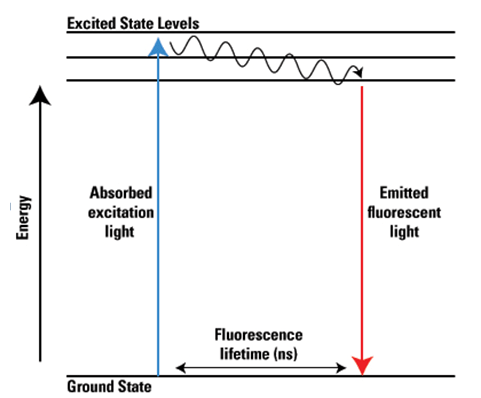While chemiluminescence and fluorescence are used interchangeably, especially when referring to tracking strategies for magnetic separation in biosensors or in-vitro diagnostic assays, however, they are different concepts. They both give off a photon as an electron relaxes from a higher energy state to a lower energy state, but the difference lies in the method used to excite that electron to a higher energy state in the first place. In fluorescence the electron is kicked up to a higher energy state by the addition of a photon. In chemiluminescence the electron is in a high-energy state due to the creation of an unstable intermediate in a chemical reaction. Light is released when the intermediate breaks down into the final products of the reaction.
.png?width=600&name=Design%20(42).png)
What is Chemiluminescence ?
Chemiluminescence is the emission of electromagnetic radiation (ultraviolet, visible or infrared) observed when a chemical reaction yields an electronically excited intermediate or product, which either luminesces or donates its energy to another molecule responsible for the emission. No light source is required to be added to the reaction in order to produce light in a chemiluminescent reaction. The chemical reaction itself produces a high-energy intermediate species in an excited state. High-energy intermediates are often oxidized species that release light as they fragment into lower energy final products.
Chemiluminescence is used in forensic medicine, night clubs and happens naturally in living glow sticks.
An example of a Chemiluminescent reaction
Luminol + hydrogen peroxide produces oxidized luminol in a high energy state, which releases light as it relaxes to a more stable energy state. The amount of light released can be increased up to 1000 fold with the addition of HRP and a substrate such as iodophenol, which produces a high energy phenolate radical intermediate.
Chemiluminescent reactions in magnetic IVD assays
Through sandwich hybridization techniques, a chemiluminescent enzyme such as HRP or AP can be attached to a target molecule or nucleic acid and a magnetic particle. Following magnetic separation the presence or absence of the target can be evaluated by adding the chemiluminescent substrate and measuring the amount of light produced. If the target molecule was present in the sample there will be light due to the chemiluminescent reaction. If the target molecule was not present in the sample then no reaction will occur and no light will be produced. This measure can be quantitative if standard curves are used.

What is Fluorescence ?
Fluorescence is the emission of light from a substance that previously has absorbed energy. This type of substance has to absorb light or any other electromagnetic radiation to emit light as fluorescence. Furthermore, this emitted light is a type of luminescence, meaning it emits spontaneously. The emitted light often has a longer wavelength than the absorbed light. That means the emitted light energy is lower than absorbed energy.
Excitation
The first step toward making a fluorescent molecule emit light is to excite an electron into a higher energy level by exposing the molecule to light of an appropriate wavelength. This is called the excitation spectrum. Different fluorescent probes are excited by different wavelengths of visible light. For example, the valence electrons in AlexaFluor 594 are kicked up to a higher energy state by the input of photons of 590 nm light, while Alexa Fluor 488 is excited by 496 nm light.
Emission
The electrons are not stable in this higher energy state and will relax back down to a lower energy state. This relaxation is quantized, meaning that it is like steps on a ladder. The electrons of a particular probe will always fall back to the same rung of the ladder, and will always release that excess energy as photons of a certain color. If excited with a proper wavelength, Alexa Fluor 594 will always emit red light with a wavelength of 617 nm, and Alexa Fluor 488 will always emit green light with a wavelength of 519nm. This light can be qualitatively measured by eye, and can be quantitatively measured by fluorescence spectrometry.
Another example of fluorescence is quantum dots. Quantum dots are fluorescent nanocrystals that are so small that they are quantum confined. This means that the emission wavelength is a direct function of quantum dot size. The excitation spectrum of quantum dots is very broad, but the emission spectrum is very narrow. Quantum dots are inorganic crystals whereas fluorescent probes are molecules.
Instruments for Chemiluminescence and fluorescence
In order to gain information from a chemiluminescent or fluorescent reaction, one must have a proper method of detection. Fluorescence is more complicated because unlike chemiluminescence it requires an external excitation source. Fluorescence instruments are called fluorometers or fluorescence spectrophotometers. These instruments will start with a light source, such as a xenon arc lamp, which goes through a filter to select for the correct excitation wavelength for your sample. Light emitted from your sample will then go through another filter for a specific wavelength for your emission and finally a detector.
Fluorescence detection is done at an angle to avoid capturing the excitation light. In fluorescence the emitted light will go in all directions and you can capture it at an angle while excitation light can be detected by another detector. The change is described by “stokes shift” and visualized as peaks in fluorometer devices.
Related news:
- A magnetic molecularly imprinted polymeralternative to streptavidin magnetic beads
- A chemiluminescence magneto-actuated immunoassay for the detection of the Zika virus
- Different types of Immunoassays





